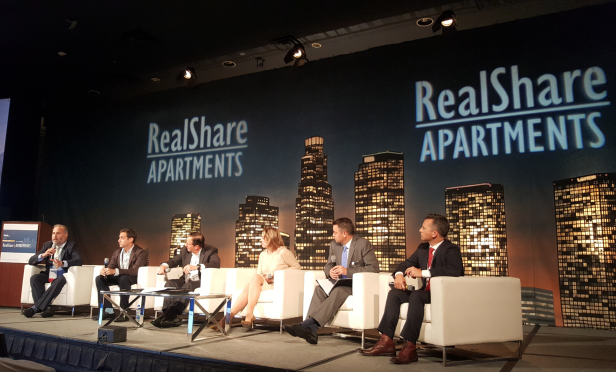 The US is the best place to invest right now globally, and multifamily is among the most compelling investment opportunity for both domestic and private capital, according to experts at RealShare Apartments this week in Los Angeles. Noah Hochman, senior managing director of capital markets at TruAmerica Multifamily; Seth K. Grossman, senior managing director at Meridian Capital Group; Joe Leon, managing director at Berkadia; Ella Shaw Neyland, president at Steadfast REITs; Adam Christofferson, SVP and division manager at Marcus & Millichap; and David Harrington, EVP and national director of multifamily at Matthews Real Estate Investment Services, spoke about the substantial foreign capital investment in the US multifamily market on the Domestic Investment: Navigating the Field Amidst Growing Foreign Investment panel at the conference.
The US is the best place to invest right now globally, and multifamily is among the most compelling investment opportunity for both domestic and private capital, according to experts at RealShare Apartments this week in Los Angeles. Noah Hochman, senior managing director of capital markets at TruAmerica Multifamily; Seth K. Grossman, senior managing director at Meridian Capital Group; Joe Leon, managing director at Berkadia; Ella Shaw Neyland, president at Steadfast REITs; Adam Christofferson, SVP and division manager at Marcus & Millichap; and David Harrington, EVP and national director of multifamily at Matthews Real Estate Investment Services, spoke about the substantial foreign capital investment in the US multifamily market on the Domestic Investment: Navigating the Field Amidst Growing Foreign Investment panel at the conference.
Canadian capital has been by far the most active in the US real estate market, and on the flip side, Chinese investment has tapered as a result of outbound capital restrictions put in place by the Chinese government in late 2017. Much of the capital is flowing to New York. In general, foreign capital has created competition in the US and has been a major driver of pricing. As a result, many sellers are more attracted to foreign buyers, but Christofferson said that sellers should be careful to properly vet international capital. “We have learned that there have been a preconceived notion that a foreign invertor is a better investors, that isn't always the case,” he said on the panel. “You have to understand their equity and make sure that they can perform.”
Still, brokers are marketing properties nationally to attract foreign buyer pools and create competition for an asset. “As a broker, our number one goal is to create competition, and casting a wider net is now on a global scale,” added Harrington. “Foreign investors have a different motivation than solving for an IRR. It plays into creating more competition and driving up values.”
While it is important to vet foreign capital—as it is with domestic capital—and affirm that it can perform, foreign capital has become a major player in the US real estate markets, and Asian investors in particular are starting to chase multifamily assets. Shaw Neyland explained that they are beginning to understand institutional multifamily ownership—a new concept for them—and as a result, is starting to move into more secondary markets and understand the fundamentals there.
Most of the foreign players are long-term holders and take a long-term view of the market. As a result, according to Shaw Neyland, these investors are not impacted by American political cycles and rising interest rates, because they believe their investment will outlive political cycles. In the end, real estate and US markets offer less volatility than other investments and other markets, making the US an attractive play.
The conversation ended with a look forward to where interest rates are heading in the next 12 months. Most of the panelists agreed that rates would drift up slightly in the next year, but no higher than 70 basis points. Harrington also predicted that the 10-year Treasury would be up 50 basis points in the next year.
© Touchpoint Markets, All Rights Reserved. Request academic re-use from www.copyright.com. All other uses, submit a request to [email protected]. For more inforrmation visit Asset & Logo Licensing.






